What separates a good coach from a great coach?
A coach can be considered good if he does one of two things. One: He looks at his squad and says, “Right then, these are my players. I will build a system to suit them.” Then he creates a system, plugs in players, and off they go on a fine run of form. Eventually, people either figure out the system or the players who excel are poached off and regress to their mean elsewhere, and the coach moves on to a new position. Two: The coach arrives with a system and convinces the team to buy into it and work their tails off to make that system work. Eventually, people either figure out which players don’t fit the system well and attack them or the players don’t buy in and Roy Hodgson moves on to West Bromich Albion.
In both “good coach” scenarios, the coach arrives, surveys the scene, and puts a plan into place. And in both scenarios, trouble arises when adjustments need to be made.
But a great coach?
A great coach makes those adjustments, makes the players understand them, and successfully counters the opposition’s weaknesses without subtracting from the areas in which his or her own team excels. A Special One makes these adjustments game to game. Think Mourinho’s Inter Milan going into a ridiculous 25-yard high shell against Barcelona and surviving. Or the same Mourinho turning Pepe into Lionel Messi’s unwanted Samwise Gamgee in the Copa Del Rey final.
These adjustments seem logical. But teams excel playing a certain way, and disrupting that rhythm can often result in more stumbles than successes.
How to fix it
The Philadelphia Union’s 5-3-2 tactics were poor in both theory and execution. But what exactly was it that was so wrong about adding a big defender against a team that likes crossing? And while it would be easy to point to the scoreboard and say, “Umm, hello?”, that response has little to offer when the Union were held scoreless in the second half (in a 4-4-2) and must face the Dynamo again on Thursday.
Emergency room space is a major issue in the US. In many cities, there aren’t enough beds for all the people that need them. One solution is to build more hospitals. Another solution is to reduce emergency room visits by addressing the health problems that, unchecked, lead to ambulance rides. Peter Nowak and his team looked at the Dynamo’s recent run of good form and decided they needed more hospitals. Specifically, a 6’0″ tall Brazilian hospital right in the center of town.
Meanwhile, Houston possessed the ball and move it around the park with relative ease in front of a low-pressure three man Union midfield. Then they crossed it in.
Houston is really quite good at crossing the ball. That was the issue the Union should have addressed, either by playing a 4-2-3-1 and allowing the center mids to help wide or by playing high pressure on the Dynamo D and forcing them to play it long.
Because when a high quality cross is whipped in and a striker is running through, three guys won’t help you much unless they have an intuitive understanding of their positioning and responsibilities. Say, an intuitive understanding honed from over thirty games next to each other.
Clearly, the Union saw the problem but bungled the solution. Let’s look at how they can patch things up before Thursday.
Press higher
Here we can see clearly one way that the Dynamo found success. Adam Moffat is nearly at the bottom of the circle in Union territory and still Brian Carroll is not pressuring. Meanwhile, both Houston strikers are being double-covered. This despite the fact that—and let’s be very clear about this—the Union have the best central defensive pairing in MLS and Houston does not have a striker that scored more than 5 (Five! Cinco! Cinq!) goals this season.
Without involving their outside backs in the play, the Dynamo have acres of space and multiple options. Moffat can try and squeeze a ball to the unmarked Camargo in the middle or he can find Danny Cruz on the right. Michael Farfan is caught trying to read the play while Sebastien Le Toux—who isn’t supposed to have defensive responsibilities if the backs aren’t involved—is not covering Cruz’s run.
Houston found a lot of success by meandering into the Union’s half, playing the ball wide and pulling Gabriel Farfan up on the wide midfielder, then running a striker in behind. In a 4-4-2, this isn’t an issue. The wide midfielder picks up the first wide player and Garfan is hanging out and picking up the striker’s run. On Sunday, the strikers were able to drag Danny Califf wide. This is a terrible thing because, simply put, it means Califf is not in the box. And even if Stefani Miglioranzi was the second best player on the team at defensive headers, he wouldn’t be a dwarf planet’s moon in Danny Califf’s defensive header solar system (the Bearfight Nebula).
Defensive communication
Positioning issues manifested themselves in other ways as well. Above, Carlos Valdes drifts a few yards in front of the other two center backs. Califf has Ching and Migs has Carr, so what’s a lonely center back to do? As Valdes leaves, Calen Carr pulls off of Miglioranzi, who was not prepared to follow the striker, assuming that Valdes would be to his right. Sheanon Williams is even higher up the pitch, trying to force Corey Ashe into a long ball with tight defense on Brad Davis. Ashe’s long ball should be easily dealt with, but Carr finds himself free and suddenly the Dynamo are setting up for another well-whipped cross.
All season, Carlos Valdes has done a remarkable job of hounding strikers when they check short, then outrunning them when they go long. On Thursday, Valdes must return to that tight marking role that fits his skill set so well. Carlos is a wanderer when he doesn’t have someone to mark. Just watch him closely next time the Union face a one striker system. Giving Valdes a clear defensive responsibility plays into his strengths in every way.
Understand the opponent’s tendencies
A final issue to address before Thursday is the gap between the defense and the midfield. Moffat and Camargo in the middle are not the types of players who will drive through a defense. They want time and space to work the ball around or blast a shot from distance. Without a Geoff Cameron storming through the center, Brian Ching will drop into the gap behind the midfield.
If Ching goes, Brian Carroll and the defense must work out who picks him up. In the image above, Ching is in the process of sending through a questionably onside Calen Carr. Carr won the initial header to Ching and the big striker was able to turn and find Carr with a return pass because the defense (and you can clearly see them doing this) backs off in unison. A third center back may start deep, but he should have license to follow a striker should said striker drop deep. Technically, one of the advantages of a three center back formation is that one can leave and chase a striker who drops into false nine positions between the lines.
On Sunday, Ching found space with alarming regularity while Moffat and Camargo rarely tried to break down the Union defense on the dribble. Understanding this trend and confronting it will be a big key to winning back some of that final third possession that Houston wants so dearly.
Why?
The above image is unrelated to the above discussion but it highlights a pet peeve of mine. Why set a high defensive line here? I can sort of understand it if you think the other team doesn’t have a set piece specialist because then you are asking the kicker to guesstimate where the ball should go. But this is Brad “B-Rad/Bradatat/Big Bad Brad” Davis. If set pieces were vampires, he’d be I Am Legend. He kills ’em!
When Brad Davis is over the ball, you have to expect it to go to a dangerous area. So why not set up in that area? Or at least set up deep enough that you can come out and meet the strikers. As it is, defenders are being asked to guess the runs of players who are often bigger/faster than them and who know where they want to go. Is the hope really that someone will stray offsides? To paraphrase the end of Michael Bluth’s conversations with Tobias Funke: “There’s gotta be a better way to play that.”
A couple more pieces of miscellany:
See that guy with his legs half-spread in a semi-jumping position near the front of the Houston six yard box? That’s Brad Davis. See his right elbow way out from his body? That’s what the ball is hitting.
Now see the referee staring intently at this point where both a soccer ball and a human arm are attempting to occupy the same space?
I guess the no-call shouldn’t be too surprising since the ref apparently (and oh so thankfully from the Union fan’s POV) didn’t get a good look at this either:
One final note
There was a nasty rumor going around the professional Union punditry to the effect of: Tally Hall is the Dynamo’s weak point. That is, of course, crazy.
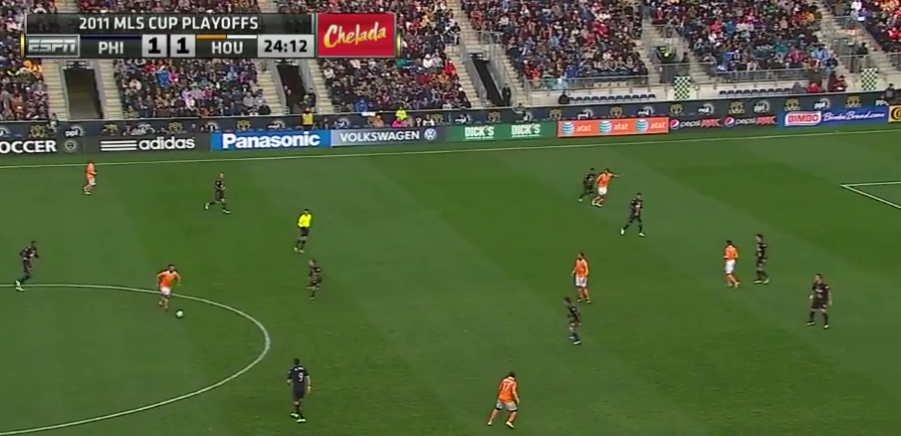
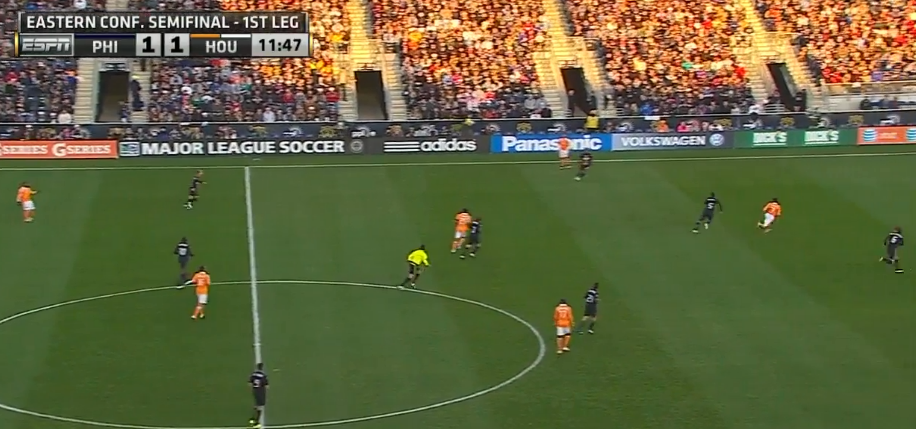
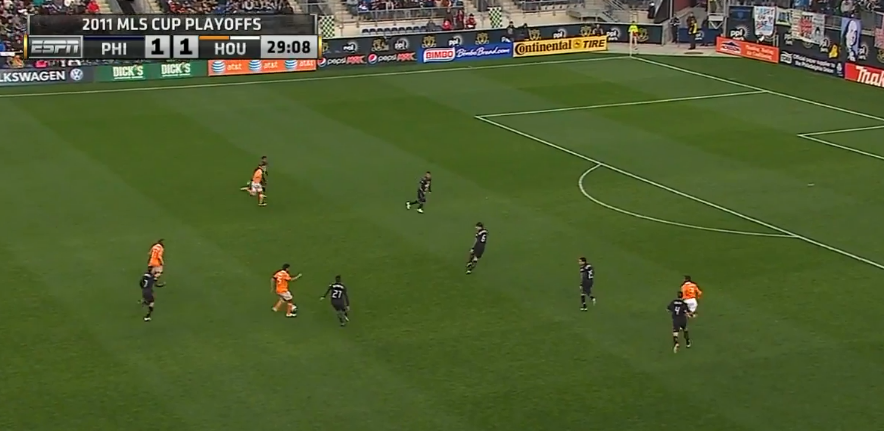
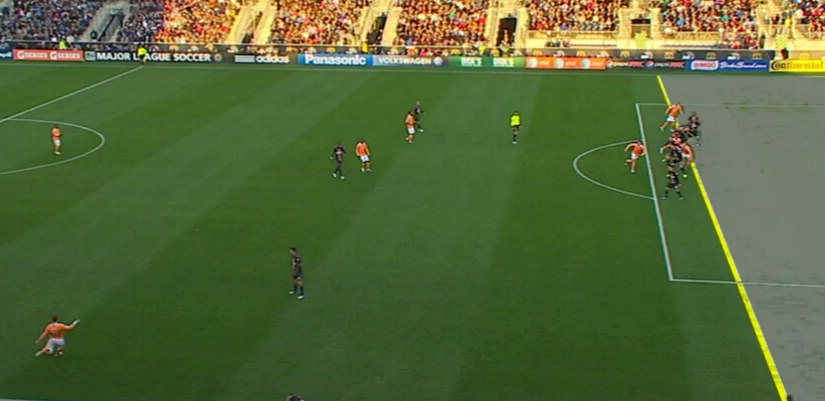
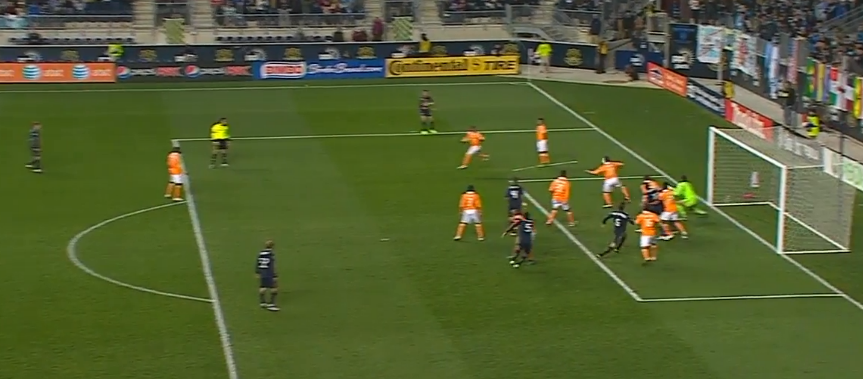


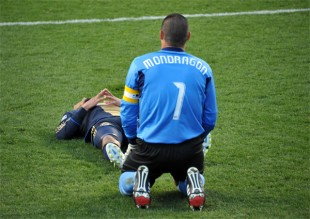

Really good job on this article! Hopefully, our autocrat of a head coach is coming to similiar conclusions.
He has to…he totally knew he effed up and looked like a fool to his team, the fans and the whole league
This is the best piece of Union-related analysis I’ve read all year.
Great article.
I love how we have reached the point where we do not even mention the fact that Peter Nowak used a defensive midfielder as a third CB instead of the CB on our roster that makes $225,000 a year.
Do we know if Nowak has employed a 4-2-3-1 this season? I was thinking that he used it during the New York game with Okugo/Carroll, but looking back at the game it appears that Pfeffer is more working as an ineffective second striker.
I can’t quite remember which match (I’ll look it up) but Michael Farfan had one of his better games starting alongside Carroll as a 2nd Dmid with more license to roam. It was right at the beginning of his current run in the starting XI.
Columbus. You suck Robbie Rogers.
I knew Eli would know it!
No offense to the guy, but I REALLY don’t want to see Pauno play for us. I don’t want him to start, and leave Le Toux on an island. I think his presence will hurt more than help.
I respectfully disagree. Yes, Pauno does drift back to try to find the game, but he also does a good job of being a supporting-striker for Le Toux (like Moreno last year). His presence help Le Toux do what Le Toux does best: make runs into space. As such, I think he makes Le Toux more effective, and I would start him if it was my call.
I’m not sure, we totally were offensively inefficient for most of the games Pauno started up top; to the point where even Twellman during broadcasts was complaining about Pauno drifting around too much and leaving Le Toux all alone. We saw plenty of times in these past few weeks where Le Toux would get the ball, look up, and have to wait for people to get into the box.
I know I must be Jack Macs biggest fan on here by now, but I really think he deserves a start and can bring us exactly what we need.
Same starters as last game with Pauno instead of Migs and Torres instead of Mapp. That seems like the solution to me.
This, of course means that Nowak will likely play the same as last game, but replace Marfan with Pfeffer and LeToux with Gonzales (and go for a 6 back set)
Adam, this article sparkles. The thought and work put into it is revealed in the photos, which I enjoyed studying with your analysis to hand.
Hopefully tomorrow means we don’t need good analysis, and we can just say “Rah, rah, Rah.”
Awesome piece Adam. I’d pay to read this kind of writing.
I can’t wait for tommorrow’s game.
Bearfight Nebula!
Let’s not give them any ideas!